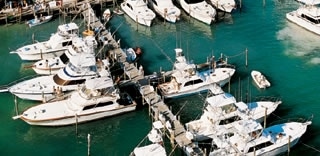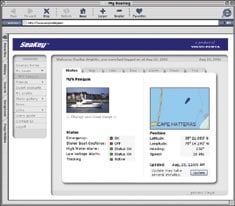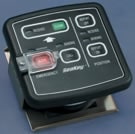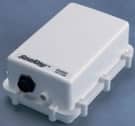
| The SeaKey system protects vessels left at a slip or mooring by issuing a warning if the bilge water level gets too high or the boat is moved from its present location. |
There’s a new player in the marine-safety and communications world, and its name is “telematics.” That’s the buzzword you’ll be hearing in the months ahead. It’s a combination of “automatic” and “telemetry,” and it’s the generic term for communication via satellite.
The first and, to date, only telematic service for boaters is offered by Volvo Penta under the name “SeaKey.” The service provides location tracking (including theft detection), emergency signaling, systems monitoring and concierge services. You can think of SeaKey as the marine version of General Motors’ OnStar system for automobiles.
In fact, the system springs from Volvo’s worldwide satellite monitoring system for the trucking and freight industries. The same Volvo Action Service Centers that monitor commercial hauling via satellite have simply been expanded to accommodate the particular needs of recreational boaters. The security and safety this kind of system can bring to boaters in an often uncertain environment is unprecedented.
Clint Moore, president and CEO of Volvo of the Americas explains: “Volvo is a company with many divisions with an enormous amount of new technology emerging. We saw this technology – telematics and SeaKey – as an enabler that could bring a new level of peace of mind and safety to the boating experience.”
How It Works

A web-based computer program lets SeaKey subscribers access current information about their boat from a home computer.|
The heart of the system is the communication link between your boat and the nearest Volvo Action Service Center. When you become a member of SeaKey, you fill out a personal profile that lists your boat size and description, emergency contacts, medical history and other pertinent information. When the center receives a message from your boat, a technician looks at a split screen with your profile and a map showing the location of your boat. Using this information, he can comply with instructions you have supplied to solve whatever problem may have come up. Contact is via cell phone, VHF or satellite phone. In addition, you can access information on your boat through your own computer, via the SeaKey website and your personal page.
In terms of equipment, the system requires the installation of a so-called “black box” (it’s actually white) in a discreet location, an Operator Module at the helm, and two wires running to the bilge. You’ll also need a subscription to SeaKey, currently $360 a year.
“In our experience with trucks and buses,” says Moore, “we know that the first thing a thief does is tear off the antenna on a stolen vehicle. So we built the antenna into the black box, where it is hidden and there is no way it can be disabled without sending a signal.”
The Operator Module controls the functions and allows limited data communication. Expanded communications capabilities from the module are under development, and should be available soon.
Security Applications

Volvo Action Service Center representatives help the boat owner monitor his vessel and can even provide immediate information on marinas, restaurants and repair services.|
Primary to the SeaKey system benefits is position tracking. This has several applications. First of all, it allows you to engage something known as “geofencing.” This means you set GPS coordinate limits on the boat, and if it moves beyond the specified location, the service center and your web page are notified. The obvious application here is theft detection. If the boat is moved from its location without your approval, the alarm goes off. It can also save you a drive in nasty weather to see if your boat is still moored or docked. You can simply check your boat’s page on the SeaKey website to find out exactly where it is.
You can also use SeaKey to program a float plan. Enter a set of coordinates for a given date, and if you fail to show up by that date the service center is alerted that you are overdue. Family and friends can also track your progress, long range or on day trips, from home, via the website once they have the password.
Emergency Features
SeaKey is also useful in an emergency situation. For example, the Operator Module at the helm is equipped with an emergency button. When you activate it and the service center is notified, a red light blinks on the panel. When the center receives your signal, the red light turns to green. Once assistance has been summoned, the light goes out, letting you know that help is on the way.
“If you are a member of a towing plan, like SeaTow,” says Moore, “we contact them directly. If they are unable to respond, we will send the Coast Guard.”
SeaKey currently includes two onboard monitoring functions: a power indicator and a high-water alert. If your boat is losing electrical power, or if water rises in the bilge, a message is sent to the service center. “We had a case recently in Maryland, with a Carver dealer,” says Moore. “We received a message that the boat was losing power. We contacted the dealer, who said, ‘No way. I’m looking at the boat right here.’ A short time later he called back to say he had forgotten to plug in the shore power.”
The power and high-water monitors are just the beginning in monitoring capabilities. “What is going to happen,” says Moore, “is with generations two, three, four and five of SeaKey, we will add even more capabilities. And the white box (provided with the original system) is not going to be obsolete. Boaters will be able to add new features because the box has the horsepower to accommodate upgrades.”


The SeaKey Operator Module (top) is mounted near the helm station, while the “black box” (bottom) containing the system’s antenna can be concealed elsewhere on the boat.|
SeaKey even offers concierge services. Say you are cruising the Intracoastal Waterway and need a slip for a couple of days, a marina with fuel, a hotel and a rental car. Call the service center and it will all be arranged. SeaKey can even arrange for repairs, or tell you the location of a restaurant for a lunch stop. This can be handled via cell phone or through the website.
Who Needs It?
“I have never seen a technology embraced with such speed as this has been by dealers and boatbuilders,” says Moore. “The reaction from boaters has been just as enthusiastic, too. One of the things we are surprised at is the positive reaction from runabout buyers, the entry-level category. The appeal was surprising, for the first-time buyer, for the safety and security the system provides.”
In launching the program, Moore explained SeaKey had met with a number of insurance underwriters. “They are going nuts over it,” he says. “We understand there will be a significant insurance premium reduction on boats equipped with SeaKey. And we speculate that on a 30- to 35-foot boat, the owner will be cash-flow positive for the premium in light of the membership fee.”
Currently, SeaKey is only available as original equipment from the boat manufacturer, but as the system develops, it will be available for retrofit on existing boats. You should be able to set your boat up with SeaKey by the end of next summer, according to Moore.
Genmar Boats of Sarasota, Florida, sells some 70,000 boats a year. A buyer-service program, known as First Mate, offering tow service and other extras, is provided free for a year with every boat Genmar sells. This year the upgraded program, First Mate Plus, includes a year’s subscription to SeaKey.
“Our relationship with SeaKey,” explains senior vice-president of marketing, George Sullivan, “is that Genmar is the largest user of this program. Every boat we build over 24 feet is equipped with the SeaKey system.” For fishermen, that means every Aquasport, Hydra-Sports, Wellcraft, Sea Swirl, Triumph or Ranger over 24 feet comes with the SeaKey system as standard equipment, plus a year’s subscription, in addition to the other services in the First Mate package.
Genmar uses the Volvo service centers, but they also have a dedicated group of people who respond especially to Genmar customers. “We have added greatly to what the SeaKey program is for the Genmar First Mate program,” says Sullivan. “We have an exclusive contract with SeaTow in North America as part of the First Mate program. We have also hired consulting firms to work with service-center operators and owners, to make sure we have the level of service our customers expect. We include an enlarged proprietary database for our own people. We felt that if we were to willing to provide the equipment and provide one year of use, people would figure out how important it was to them for security, information and service.”
Or convenience, as Sullivan explained. “I used to drive 60 miles to see if my boat was still in its slip when it was windy. If I’d had this system I could have checked on my boat via the website and gone back to bed.”
The network of Volvo Action Service Centers is constantly expanding toward global coverage. It’s simply a matter of making the investment in the facility and turning on satellites, Moore explains. Right now, SeaKey coverage is available in North America, the Caribbean, Canada, Central America, some of northern South America and Belgium. There is one service center in Australia and one in Asia.
For more information on the SeaKey system, contact Volvo Penta of the Americas, (866) 473-2539 or (336) 393-4507 (outside U.S.); www.volvopenta.com/us/seakey.









